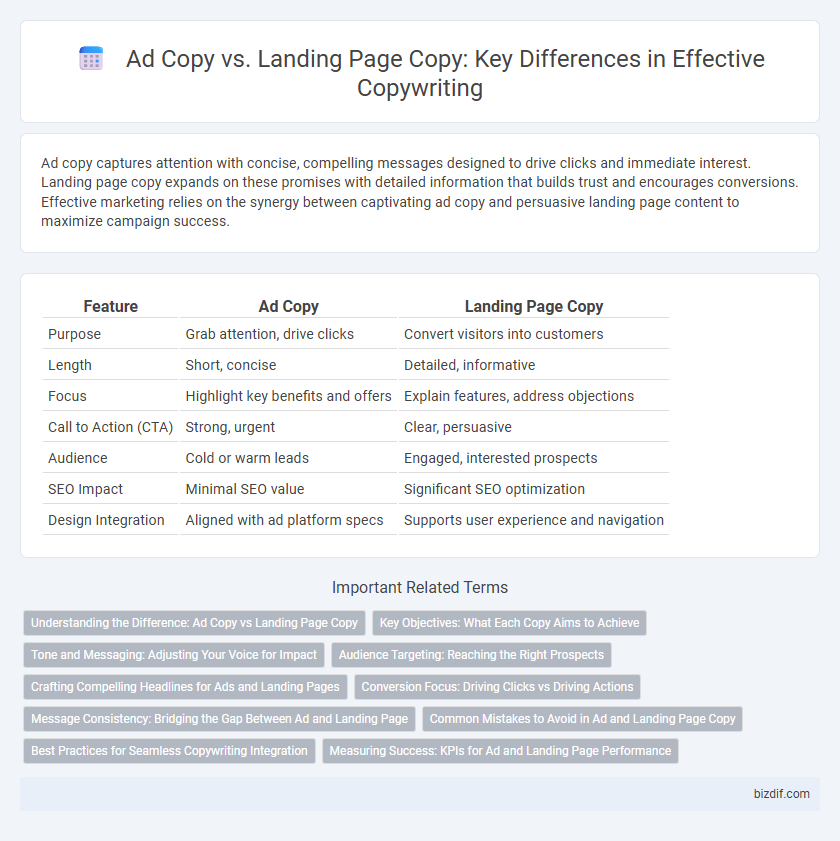Ad copy captures attention with concise, compelling messages designed to drive clicks and immediate interest. Landing page copy expands on these promises with detailed information that builds trust and encourages conversions. Effective marketing relies on the synergy between captivating ad copy and persuasive landing page content to maximize campaign success.
Table of Comparison
| Feature | Ad Copy | Landing Page Copy |
|---|---|---|
| Purpose | Grab attention, drive clicks | Convert visitors into customers |
| Length | Short, concise | Detailed, informative |
| Focus | Highlight key benefits and offers | Explain features, address objections |
| Call to Action (CTA) | Strong, urgent | Clear, persuasive |
| Audience | Cold or warm leads | Engaged, interested prospects |
| SEO Impact | Minimal SEO value | Significant SEO optimization |
| Design Integration | Aligned with ad platform specs | Supports user experience and navigation |
Understanding the Difference: Ad Copy vs Landing Page Copy
Ad copy aims to capture immediate attention and generate clicks by delivering a concise, compelling message tailored to specific audience segments. Landing page copy provides detailed information, builds trust, and guides visitors through the conversion funnel with persuasive content and clear calls to action. Recognizing the distinct roles of ad copy and landing page copy is crucial for creating a seamless user journey that maximizes conversion rates.
Key Objectives: What Each Copy Aims to Achieve
Ad copy aims to capture attention quickly and provoke immediate interest or action, focusing on concise messaging and strong calls-to-action to boost click-through rates. Landing page copy prioritizes educating visitors, addressing objections, and guiding them through the conversion funnel with detailed information and persuasive content. Both types of copy work synergistically, with ad copy driving traffic and landing page copy converting that traffic into leads or sales.
Tone and Messaging: Adjusting Your Voice for Impact
Ad copy leverages a concise, persuasive tone designed to capture immediate attention and motivate quick action, often incorporating emotional triggers and clear calls to action. Landing page copy adopts a more detailed, informative tone that builds trust and addresses user concerns by balancing benefits with features, fostering a deeper connection through clarity and relevance. Tailoring voice for each format maximizes engagement by aligning messaging with user intent and the decision-making stage in the marketing funnel.
Audience Targeting: Reaching the Right Prospects
Ad copy focuses on capturing attention and generating clicks by appealing to specific audience segments with concise, compelling messages tailored to their interests and pain points. Landing page copy deepens engagement by providing detailed information and persuasive content that addresses the prospect's needs and guides them toward conversion. Both forms of copywriting rely on precise audience targeting to ensure relevance and maximize return on investment in digital marketing campaigns.
Crafting Compelling Headlines for Ads and Landing Pages
Crafting compelling headlines for ads and landing pages requires clear, concise messaging that immediately captures attention and communicates the core benefit. Ad copy headlines must be punchy and persuasive to generate clicks, while landing page headlines focus on reinforcing interest and encouraging conversion with detailed value propositions. Both types of headlines leverage targeted keywords and emotional triggers to optimize engagement and drive results in digital marketing campaigns.
Conversion Focus: Driving Clicks vs Driving Actions
Ad copy is crafted to capture attention and drive clicks through compelling headlines and concise messaging, targeting immediate engagement. Landing page copy focuses on guiding visitors toward specific actions, such as form submissions or purchases, by providing detailed information and persuasive calls to action. Effective conversion optimization requires aligning ad copy's click-driving appeal with landing page copy's action-oriented content to maximize overall campaign success.
Message Consistency: Bridging the Gap Between Ad and Landing Page
Message consistency between ad copy and landing page copy enhances user trust and increases conversion rates by delivering a seamless experience. Aligning headlines, tone, and key benefits ensures that visitors recognize the value proposition immediately upon arrival. Maintaining this coherence reduces bounce rates and reinforces brand credibility throughout the customer journey.
Common Mistakes to Avoid in Ad and Landing Page Copy
Common mistakes in ad copy include vague messaging and lack of a clear call-to-action, which reduce click-through rates and conversions. Landing page copy errors often involve inconsistent tone, overwhelming information, and missing alignment with ad promises, leading to high bounce rates. Ensuring clarity, relevance, and coherence between ad and landing page copy improves user engagement and drives higher conversion rates.
Best Practices for Seamless Copywriting Integration
Ad copy should capture attention with concise, compelling language and a clear call-to-action that aligns with the landing page's purpose. Landing page copy must expand on ad promises by providing detailed information, trust signals, and user-centric benefits to maintain engagement and drive conversions. Ensuring consistent messaging, tone, and keywords between ad copy and landing page content optimizes user experience and improves overall campaign performance.
Measuring Success: KPIs for Ad and Landing Page Performance
Key performance indicators (KPIs) for ad copy focus on click-through rate (CTR), conversion rate, and cost per click (CPC) to measure how effectively ads drive traffic. Landing page copy KPIs include bounce rate, average session duration, and conversion rate, highlighting the page's ability to engage visitors and complete desired actions. Tracking and analyzing these metrics enables marketers to optimize both ad and landing page copy for improved campaign performance.
Ad Copy vs Landing Page Copy Infographic

 bizdif.com
bizdif.com